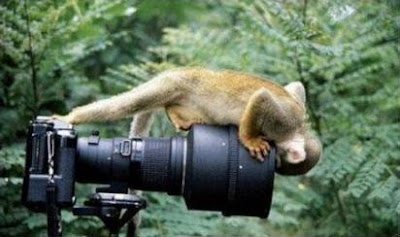I never seek coincidences, but I do appreciate them when they happen. Yesterday, December 14th, was International Monkey Day. Yes, there is such a thing as International Monkey Day... and since its inception in the year 2000, celebrations have included such engrossing activities as auctions to raise money for primate foundations, monkey costume contests, Photoshop LOLmonkey competitions, monkey sound imitation choruses and the speed-knitting of monkey dolls.
Whatever. It keeps the speed-knitters off the streets.

I have something of a healthy side-interest in primatology, and while celebrating the news items of Monkey Day, I noticed that NASA chose this time to announce that they have ceased their study of squirrel monkeys being exposed to radiation. Mixed emotions. I, like many others, grudgingly admit the basic medical value – but have never given up the hope that someday, analog simulations on the ground would be able to go forward without the use of living creatures who cannot make the conscious decision to participate.
I doubt that day has come, and this may prove to be a loss of necessary research in getting the human race to Mars, but we can all wish the now-free 18 NASA squirrel monkeys well, as they proceed to non-research facility homes. NASA's press release indicated they were undertaking a "comprehensive review of the agency's research to see how they align with the President's plan for human spaceflight." You may as well hang a neon sign that says, "BUDGET CUTS".

The year 2010 saw a decided drop in the number of monkeys being utilized for research, a favorable rise in the Mountain Gorilla population, the discovery of three new species of primates in Colombia, Myanmar and Cambodia, and the surprise photographing of a small loris in Sri Lanka once thought to be extinct.
China became the third country (after the USA and Japan) to genetically engineer a macaque, and dozens of wildlife parks and reserves are edging many simians OFF the Endangered Species lists – just one amazing example was the unprecedented survival of all FOUR sets of rare twin tamarin births: Panamanians in New York, Golden Lions in Bristol and Atlanta, and Pieds in Colchester, UK. Death by cuteness on all counts! And, victories for the hard workers of many breeding programs who are attempting, through careful lineage aligning, to ensure these beautiful animals escape the danger of extinction due to habitat loss.
The American Naturalist published the results of a 25-year study, where extinction prevention behavioral observation by 7 universities in 6 countries studied thousands of subjects, and showed that some monkeys can do math (!), other monkeys use mime and complex communications once thought restricted to humans, and that primates are far more resilient to climactic and other environmental variability than other animals.
That includes us higher primates, like humans. So, let's hope they're correct.


































































